Antibody data
- Antibody Data
- Antigen structure
- References [1]
- Comments [0]
- Validations
- Immunocytochemistry [2]
- Immunohistochemistry [7]
- Other assay [1]
Submit
Validation data
Reference
Comment
Report error
- Product number
- PA5-58351 - Provider product page

- Provider
- Invitrogen Antibodies
- Product name
- BUD13 Polyclonal Antibody
- Antibody type
- Polyclonal
- Antigen
- Recombinant protein fragment
- Description
- Immunogen sequence: PGHQDSDSDL SPPRNRPRHR SSDSDLSPPR RRQRTKSSDS DLSPPRRSQP PGKKAAHMYS GAKTGLVLTD IQREQQELKE QDQETM Highest antigen sequence identity to the following orthologs: Mouse - 86%, Rat - 81%.
- Reactivity
- Human, Mouse
- Host
- Rabbit
- Isotype
- IgG
- Vial size
- 100 μL
- Concentration
- 0.3 mg/mL
- Storage
- Store at 4°C short term. For long term storage, store at -20°C, avoiding freeze/thaw cycles.
Submitted references CircSERPINA3 regulates SERPINA3-mediated apoptosis, autophagy and aerobic glycolysis of prostate cancer cells by competitively binding to MiR-653-5p and recruiting BUD13.
Xing Z, Li S, Liu Z, Zhang C, Bai Z
Journal of translational medicine 2021 Dec 3;19(1):492
Journal of translational medicine 2021 Dec 3;19(1):492
No comments: Submit comment
Supportive validation
- Submitted by
- Invitrogen Antibodies (provider)
- Main image
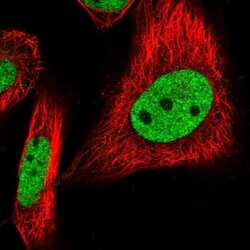
- Experimental details
- Immunofluorescent staining of BUD13 in human cell line U-251 MG shows positivity in nucleus but excluded from the nucleoli. Samples were probed using a BUD13 Polyclonal Antibody (Product # PA5-58351).
- Submitted by
- Invitrogen Antibodies (provider)
- Main image
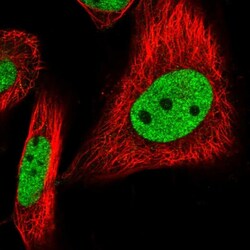
- Experimental details
- Immunofluorecent analysis of BUD13 in human cell line U-251 MG using BUD13 Polyclonal Antibody (Product # PA5-58351). Staining shows localization to nucleoplasm.
Supportive validation
- Submitted by
- Invitrogen Antibodies (provider)
- Main image
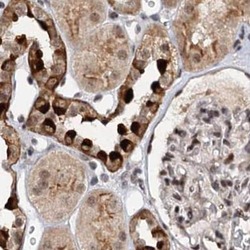
- Experimental details
- Immunohistochemical staining of BUD13 in human kidney using BUD13 Polyclonal Antibody (Product # PA5-58351).
- Submitted by
- Invitrogen Antibodies (provider)
- Main image
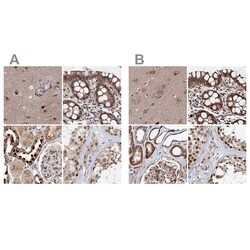
- Experimental details
- Immunohistochemical staining of BUD13 in human cerebral cortex, colon, kidney and testis using BUD13 Polyclonal Antibody (Product # PA5-58351) (A) shows similar protein distribution across tissues to an independent BUD13 Polyclonal Antibody (B).
- Submitted by
- Invitrogen Antibodies (provider)
- Main image
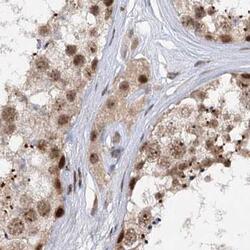
- Experimental details
- Immunohistochemical staining of BUD13 in human testis using BUD13 Polyclonal Antibody (Product # PA5-58351).
- Submitted by
- Invitrogen Antibodies (provider)
- Main image
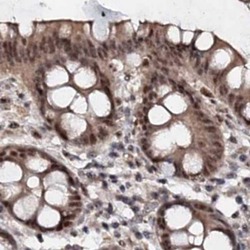
- Experimental details
- Immunohistochemical staining of BUD13 in human colon using BUD13 Polyclonal Antibody (Product # PA5-58351).
- Submitted by
- Invitrogen Antibodies (provider)
- Main image
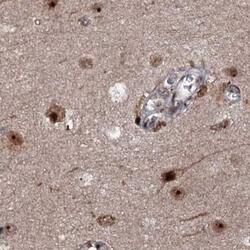
- Experimental details
- Immunohistochemical staining of BUD13 in human cerebral cortex using BUD13 Polyclonal Antibody (Product # PA5-58351).
- Submitted by
- Invitrogen Antibodies (provider)
- Main image
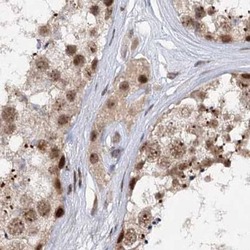
- Experimental details
- Immunohistochemical staining of BUD13 in human testis using BUD13 Polyclonal Antibody (Product # PA5-58351).
- Submitted by
- Invitrogen Antibodies (provider)
- Main image
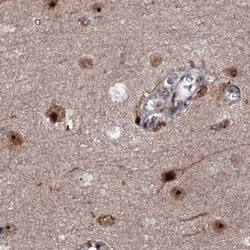
- Experimental details
- Immunohistochemical staining of BUD13 in human cerebral cortex using BUD13 Polyclonal Antibody (Product # PA5-58351).
Supportive validation
- Submitted by
- Invitrogen Antibodies (provider)
- Main image
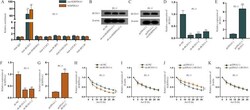
- Experimental details
- Fig. 3 CircSERPINA3 stabilizes SERPINA3 via recruiting BUD13. A RIP assay was used to examine the enrichment of circSERPINA3 and SERPINA3 in PC-3 cells incubated with different antibodies of candidate shared RBP screened out from starBase. B , C Western blot analysis was conducted to examine BUD13 expression when circSERPINA3 was down-regulated or overexpressed in PC-3 cells. D , E RT-qPCR was used to examine the knockdown efficiency of sh-BUD13-1/2/3 and overexpression efficiency of pcDNA3.1-BUD13 in PCa cells. F , G RT-qPCR was carried out to examine SERPINA3 expression when BUD13 was reduced or overexpressed in PC-3 cells. H , I RT-qPCR was used to examine the effect of sh-BUD13-1 on half-life of SERPINA3 and beta-actin in PC-3 cells. J , K Expression of SERPINA3 and beta-actin in PC-3 cells was tested by means of RT-qPCR after cells were transfected with pcDNA3.1-BUD13. ( sh short hairpin, NC negative control). ** P < 0.01
 Explore
Explore Validate
Validate Learn
Learn Western blot
Western blot Immunocytochemistry
Immunocytochemistry